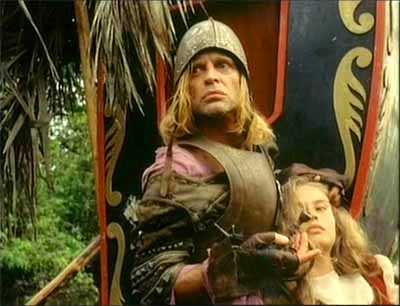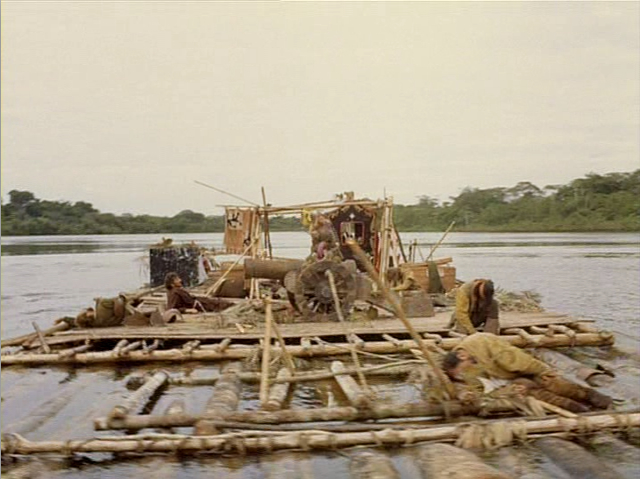From Video Times (February 1986). — J.R.
AGUIRRE, WRATH OF GOD
(1972), C, Director: Werner Herzog. With Klaus Kinski, Roy Guerra, Del Negro, and Helena Rojo. 90 min. Subtitled. Continentai, $39.95. ****
Among contemporary movies that aspire to create the resonance of myth, there are few more compelling than this 1972 masterpiece. Directed by German filmmaker Werner Herzog, the film stars Klaus Kinski in the title role. At once a 16th century Peruvian adventure story about the legend of El Dorado and a somewhat indirect parable about modern imperialism, Aguirre, Wrath of God can be regarded as one of the key influences on Francis Coppola’s 1979 Apocalypse Now. The fact that Herzog himself launched a treacherous journey through the backwaters of Peru in order to film his tale helped to popularize the notion of the director as mad Faustian conquistador. When Herzog himself attempted to surpass Aguirre a decade later with Fitzcarraldo, another insane, “historic” journey up the Amazon, the result was only a pale dilution of the original.
The film opens with a printed title that perfectly establishes the aura of legend: “After the conquest and sack of the Incan empire by Spain, the Indians invented the legend of El Dorado, a land of gold, located in the swamps of the Amazon tributaries. A large expedition of Spanish adventurers led by Pizarro sets off from the Peruvian sierras in late 1560. The only document to survive from this lost expedition is the diary of the monk Gaspar de Carvajal.” Although Herzog has admitted that the aforementioned document is a pure fabrication of his own, the Spanish conquest of the Americas — which wiped out 70,000,000 people in 150 years — is a historical fact. This provides a chilling backdrop to Herzog’s fanciful story.
Pizarro’s expedition is halted by the jungle, and he sends out a reconaissance party of 40 people, led by Don Pedro de Ursua (Roy Guerra). These Spaniards continue down the Amazon on rafts, and are gradually decimated by whirlpools, floods, and Indian attacks. When Ursua decides to turn back, the ambitious Aguirre (Kinski) stages a mutiny, pressing the survivors onward to El Dorado.
This is the basic story of Aguirre, yet the curious thing about Herzog’s epic style is that at key moments it proceeds almost at adjacent angles to the plot — the camera’s giddy movement surrounding characters and landscapes as if progressively taken over by the manic vision of its title hero. The film opens with cloud-encircled mountain peaks and only gradually do we glimpse human figures traveling down the side of one of them; these figures, descending in layers, suggest a Brueghel painting.
Made during the height of the Vietnam war, Aguirre surfaced in the U.S. five years later — delayed in part by a mistaken effort to dub the film into English (the tape reviewed here was subtitled), complete with incongruous accents. The film is an extraordinary depiction of single-minded imperialism delivered in a hallucinatory style. And as Aguirre himself remarks to narrator Gaspar de Carvajal, “The conquest of Mexico was no illusion.”
— JONATHAN ROSENBAUM



